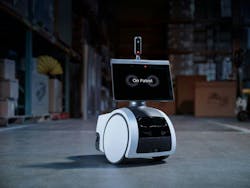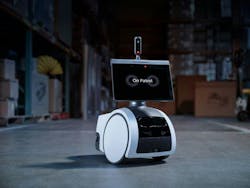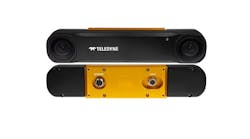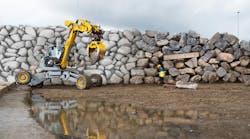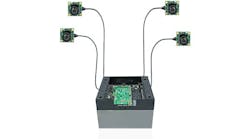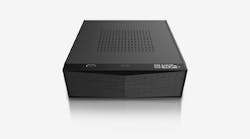Security and surveillance technologies, as a whole, are undergoing a remarkable transformation as innovations like patrol robots are on the rise. Equipped with high-performance cameras, patrol robots bring the power of edge-based AI and analytics into everyday operations.
With the ability to automate intelligent decisions, such robots are becoming increasingly popular in use cases such as:
- Warehouses: In these vast storage facilities, patrol robots help ensure security and monitor inventory. They can navigate through aisles, monitor for any unusual activities, and provide real-time updates, all while reducing the need for extensive human surveillance.
- Medical facilities: Security and privacy are major concerns in medical facilities like hospitals. Patrol robots enhance the safety of these environments by monitoring restricted areas and ensuring that safety protocols are followed while being capable of responding to emergencies.
- Office buildings: Large office buildings are an ideal candidate for patrol robot deployment. These robots can perform regular security checks, monitor for safety hazards, and even assist in emergency evacuation procedures.
- Factories: Patrol robots contribute to security and operational efficiency in factories and other manufacturing facilities. They can inspect machinery, monitor production processes, and ensure safety standards are met.
Other use cases include:
- Construction sites
- Oil and gas sites
- Gated communities
- Large sports arenas
Related: Mobile Robots Use Machine Vision to Deliver Food
Imaging-related challenges faced by patrol robots
Before we uncover the various roles played by cameras in modernizing patrol robots, it's important to be aware of the imaging-related challenges. Let's look at the major hurdles first.
- Environment adaptability: Cameras must perform reliably in different environmental conditions, including varying light levels, weather conditions, and the presence of obstacles or distractions.
- Bandwidth limitations: The high volume of data generated by advanced camera systems requires a lot of processing power and bandwidth for real-time analysis. So, it can be challenging to equip patrol robots with enough computational resources.
- Accuracy of recognition: Ensuring high accuracy in object detection, facial recognition, and pattern analysis can be taxing. It requires algorithms and AI models that can learn and adapt to different scenarios. The challenge is compounded when these systems need to operate in crowded or complex environments where distinguishing between objects and individuals becomes more difficult.
- Power Consumption: Camera systems that require continuous operation and real-time data processing consume a significant amount of power. This presents an issue in balancing the need for advanced imaging capabilities with the limitations of battery life and power management.
Role of cameras in modernizing patrol robots
Embedded cameras function as sensory inputs, directly feeding into algorithms responsible for tasks like autonomous navigation and environmental analysis. They enable the robots to process complex visual data, essential for operations like obstacle avoidance, path planning, and surveillance.
Key aspects include:
- Depth sensing: Leveraging technologies like time-of-flight, stereo vision, and structured light for accurate depth perception is crucial for SLAM (simultaneous localization and mapping) algorithms.
- Real-time processing: Cameras equipped with high frame rates and resolution, coupled with onboard processors (GPUs or AI accelerators), allow for immediate data processing and decision-making.
- Field of View (FOV): The design and placement of these cameras, whether single or multiple units, determine the extent of the robot's surveillance ability.
- Low-light performance: For facial recognition and night-time operations, cameras with high dynamic range and sensitivity to low-light conditions are crucial.
Related: Autonomous Mobile Robot Aided by 3D Vision Harvests Sweet Peppers
Now, let’s look at the multi-faceted role played by cameras in patrol robots.
Driving autonomous navigation
Patrol robots use advanced 3D depth-sensing technologies, such as time-of-flight (ToF) cameras, stereo vision cameras, and structured light cameras. Each delivers advantages in depth perception and environmental mapping. For instance, ToF cameras calculate the time it takes for light to reflect from objects, thereby creating a depth map of the surroundings.
Stereo cameras, using two or more lenses, simulate human binocular vision to perceive depth. In contrast, structured light cameras project a pattern of light onto the scene and analyze its distortion to measure depth.
This depth information is crucial for implementing SLAM (Simultaneous Localization and Mapping) algorithms, facilitating real-time navigation, obstacle detection, and avoidance.
Enhancing surveillance with video analytics
The video capture capabilities of patrol robots are augmented with edge-based AI analytics. They utilize convolutional neural networks (CNNs) and other machine learning models to analyze video feeds in real-time. For intrusion detection, the algorithms process pixel patterns to recognize human figures or other predefined shapes within a specific distance, typically between 100 to 200 meters.
The robots' processing units, equipped with GPUs or specialized AI accelerators, analyze this data, making instantaneous decisions on potential threats. The camera's FOV and resolution play a crucial role here, determining the quality and extent of the surveillance area.
Enabling 360-degree video-based monitoring
For scenarios requiring a broader surveillance scope, patrol robots employ 360° cameras. These cameras are integral for applications like remote monitoring, where operators control the robots from a distance. The data captured is used for real-time surveillance and post-event analysis.
Advanced image processing techniques, such as object tracking algorithms and pattern recognition, are used to analyze the footage, providing insights into pedestrian movements, vehicular traffic, and other environmental conditions.
Delivering facial recognition capabilities
The implementation of facial recognition in patrol robots incorporates high-resolution cameras capable of capturing detailed facial features. These cameras require features like HDR and excellent low-light performance to ensure accuracy under changing lighting conditions. The facial recognition process involves detecting facial features, normalizing the image, and then matching it against a database using deep learning algorithms.
Given the processing complexity and the need for high accuracy, facial recognition is generally effective within a shorter range, around 40 to 50 meters.
Final thoughts
The evolution of patrol robots, driven by embedded vision technology, will continue automating and transforming surveillance and security. However, addressing the challenges involved will be crucial in realizing the full potential of these robotic systems in various functions, ranging from industrial security to public safety.
The ongoing advancements in camera technology and AI will undoubtedly influence the future of patrol robots, as well as making them more future-proofed.
